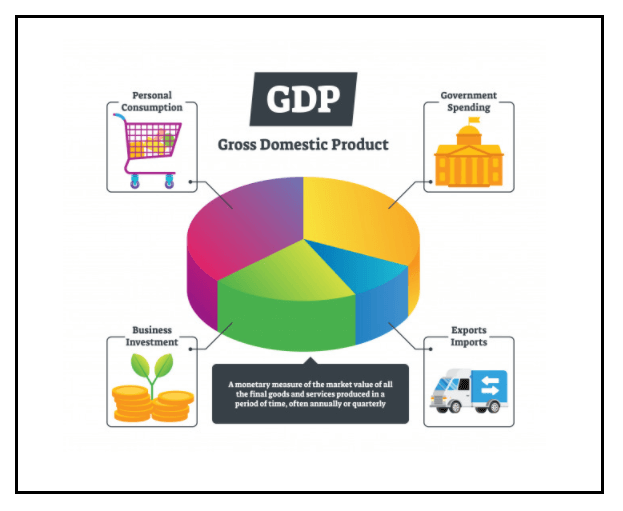Full Form of GDP
Full Form of GDP
We often came across the word GDP in debates, news, talk shows, and various other economic factors. Economists mostly refer to this word while speaking about the size of the economy. GDP is an essential estimate of the overall health of our economy. But do you know what GDP stands for?
GDP stands for Gross Domestic Product.

This tutorial will briefly learn about the definition, history, advantages, method to calculate and other detailed information about the Gross Domestic Product or GDP.
Topics Covered
- What is GDP?
- History of GDP
- Why GDP is important?
- Different methods to calculate GDP
- Factors: Overlooked by GDP
What is GDP?
“GDP or Gross Value Product is the monetary value of overall goods & services produced within a country in a particular time period.”
OR
As per IMF (International Monetary Fund), “GDP is the measurement of the monetary value of overall goods and services that are manufactured in a count and purchased by the final customer in a specified period of time (particularly quarterly or yearly).”
GDP is all around us. It is an accurate pointer to measure the size of an economy, and the GDP growth rate is the sole best locater and a significant measure to locate economic growth. Unlike the UK or the US, consumer spending is responsible for influencing more than half of a country’s GDP in many developed countries. GDP is the overall measurement or consumer value of overall goods and services rendered within a country's boundaries over a specified time.
GDP is responsible for measuring the overall output, as a specific scorecard of a given nation's monetary. Whenever economists converse, discuss or debate about the size of the economy, they generally refer to GDP. The GDP of a county is directly proportional to its people's living standards, and as the GDP rises, the people’s living standards also increase simultaneously. In India, the primary factors contributing to GDP are agriculture, manufacturing, goods and services.
History of GDP

Between 1652 and 1674, an English economist and statistician named William Petty gave GDP's primary concept to defend the owners from illegal taxation. Following this, Charles Davenant worked on this concept and further expanded this method. The modern GDP concepts were still undiscovered until in 1934 when an American Economist, Simon Kuznets, interpreted the insights economic and social structure and introduced GDP. Later in 1944, GDP became the primarily used mechanism for measuring a nation's economy after the famous economist and statistician Bretton Woods conference.
Why GDP is Important?

Many economists are concluding the importance of GDP over time.
- Famous economist Samuelson and Nordhaus's ability to give an overall survey of the state's economy to a satellite in space can inspect the weather across an entire continent.
- GDP allows policymakers and central banks to estimate whether the economy is diminishing or increasing, whether it requires a lift or needs to be controlled, and any threats, unlike a recession or excessive expansion, loom on the horizon.
- The NIPS (National Income and Product Accounts) is responsible for measuring GDP, empowers policymakers, economists, and businesses to analyze the consequence of variables such as economic and financial policy and fiscal deficits.
- GDP analyzes if there is any hike in the oil price or tax.
- GDP is responsible for contributing and proposing plans on definite subsets of an economy or the overall economy.
Different methods to calculate GDP

GDP calculation only considers the goods or products that are calculated only in the year of production. There are different methods for calculating the country's GDP, and it's important to apprehend all the different ways and how they're used. In this tutorial, we will learn the three widely used approaches to calculate GDP.
- Income System
The income method measures the overall revenue obtained by various production factors such as labor and capital within a country's physical boundaries.
Formula Used: Income System
GDP = A + T – S
Where
- A stands for GDP at Factor expense
- T stands for Taxes
- And, S stands for Subsidies
- Output System
The output method includes the market value of all products and services produced within the country's borders. To prevent a skewed GDP measurement because of price-level adjustments, GDP is calculated at fixed or actual GDP prices.
Formula Used: Output system
GDP = B – T + S
Where
- B stands for GDP at a constant prize or actual GDP
- T stands for Taxes
- S stands for Subsidies
- Expenditure System
The Expenditure method involves testing expenditure on all individuals' products and services within a country's domestic boundaries.
Formula Used: Expenditure system
GDP = C + I + G + NX
Where
- C stands for Personal consumption expenditure
- I stands for Business investment
- G stands for Government spending
- X stands for Exports
- M stands for Imports
- NX is equivalent to (X – M) which means net export.
Factors: Overlooked by GDP
GDP is not completely flawless. It excuses various significant parts and does not include many factors that affect the standard of living. In particular, it overlooks the following factors:
- Externalities- Economic growth may cause an expansion in negative externalities that are not included in GDP. For example, the developed industrial production might raise the GDP, but it causes air and water pollution that are not included.
- Non-market transactions- GDP eliminates ventures that are not administered through the market, unlike household production, trading of goods and services, or unpaid and disguised services.
- Non-monetary economy- GDP overlooks economies where there is no role of money. Thus, it results in inaccurate or low GDP numbers. For example, in countries where most business transactions happen informally, shares of the local economy are not quickly manifested.
- Quality improvements- GDP underestimates real economic growth as it is not liable to adjust for quality improvements and new products. For example, today's computers are cheaper and more advanced when compared with computers from the past. However, GDP considers them the same products by only accounting for the monetary condition.
- Sustainability of growth- GDP is an analysis of past economic activity and is not significantly a projection.
- Money distribution- GDP does not estimate for fluctuations in incomes of several demographic groups.